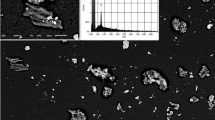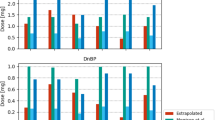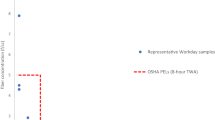Abstract
The potential for para-occupational, domestic, or take-home exposures from asbestos-contaminated work clothing has been acknowledged for decades, but historically has not been quantitatively well characterized. A simulation study was performed to measure airborne chrysotile concentrations associated with laundering of contaminated clothing worn during a full shift work day. Work clothing fitted onto mannequins was exposed for 6.5 h to an airborne concentration of 11.4 f/cc (PCME) of chrysotile asbestos, and was subsequently handled and shaken. Mean 5-min and 15-min concentrations during active clothes handling and shake-out were 3.2 f/cc and 2.9 f/cc, respectively (PCME). Mean airborne PCME concentrations decreased by 55% 15 min after clothes handling ceased, and by 85% after 30 min. PCM concentrations during clothes handling were 11–47% greater than PCME concentrations. Consistent with previously published data, daily mean 8-h TWA airborne concentrations for clothes-handling activity were approximately 1.0% of workplace concentrations. Similarly, weekly 40-h TWAs for clothes handling were approximately 0.20% of workplace concentrations. Estimated take-home cumulative exposure estimates for weekly clothes handling over 25-year working durations were below 1 f/cc-year for handling work clothes contaminated in an occupational environment with full shift airborne chrysotile concentrations of up to 9 f/cc (8-h TWA).
This is a preview of subscription content, access via your institution
Access options
Subscribe to this journal
Receive 6 print issues and online access
$259.00 per year
only $43.17 per issue
Buy this article
- Purchase on Springer Link
- Instant access to full article PDF
Prices may be subject to local taxes which are calculated during checkout








Similar content being viewed by others
References
Anderson HA, Lilis R, Daum SM, Fischbein AS, Selikoff IJ . Household-contact asbestos neoplastic risk. Ann NY Acad Sci 1976; 271: 311–323.
Edge JR, Choudhury SL . Malignant mesothelioma of the pleura in Barrow-in-Furness. Thorax 1978; 33: 26–30.
Epler GR, Fitz Gerald MX, Gaensler EA, Carrington CB . Asbestos-related disease from household exposure. Respiration 1980; 39: 229–240.
Anderson HA . Family Contact Exposure. In: Asbestos, Health and Society: Proceedings of World Symposium on Asbestos. Canadian Asbestos Information Center: Montreal: Quebec, Canada. 1982 pp 349–362.
Kilburn KH, Lilis R, Anderson HA, Boylen CT, Einstein HE, Johnson SJ et al. Asbestos disease in family contacts of shipyard workers. Am J Public Health 1985; 75: 615–617.
Gibbs AR, Jones JS, Pooley FD, Griffiths DM, Wagner JC . Non-occupational malignant mesotheliomas. IARC Sci Publ 1989, 219–228.
NIOSH Report to Congress on Workers’ Home Contamination Study Conducted Under the Worker’s Family Protection Act (29 U.S.C. 671a), NIOSH Pub. No. 95-123. September 1995In. National Institute for Occupational Safety and Health: Cincinnati, OH. 1995.
Donovan EP, Donovan BL, McKinley MA, Cowan DM, Paustenbach DJ . Evaluation of take home (para-occupational) exposure to asbestos and disease: a review of the literature. Crit Rev Toxicol 2012; 42: 703–731.
Goswami E, Craven V, Dahlstrom DL, Alexander D, Mowat F . Domestic asbestos exposure: a review of epidemiologic and exposure data. Int J Environ Res Public Health 2013; 10: 5629–5670.
Vianna NJ, Polan AK . Non-occupational exposure to asbestos and malignant mesothelioma in females. Lancet 1978; 1: 1061–1063.
Magnani C, Terracini B, Ivaldi C, Botta M, Budel P, Mancini A et al. A cohort study on mortality among wives of workers in the asbestos cement industry in Casale Monferrato, Italy. Br J Ind Med 1993; 50: 779–784.
Camus M, Siemiatycki J, Meek B . Nonoccupational exposure to chrysotile asbestos and the risk of lung cancer. N Engl J Med 1998; 338: 1565–1571.
Bourdes V, Boffetta P, Pisani P . Environmental exposure to asbestos and risk of pleural mesothelioma: review and meta-analysis. Eur J Epidemiol 2000; 16: 411–417.
Enterline PE, Henderson V . Type of asbestos and respiratory cancer in the asbestos industry. Arch Environ Health 1973; 27: 312–317.
Hodgson JT, Darnton A . The quantitative risks of mesothelioma and lung cancer in relation to asbestos exposure. Ann Occup Hyg 2000; 44: 565–601.
Berman DW, Crump KS . Final Draft: Technical Support Document for a Protocol to Assess Asbestos-Related Risk, October 2003, EPA# 9345.4-06 Environmental Protection Agency (EPA), Office of Solid Waste and Emergency Response: Washington, DC: U.S. 2003 Report no.: EPA# 9345: 4–06.
ERG (Eastern Research Group) Report on the Peer Consultation Workshop to Discuss a Proposed Protocol to Assess Asbestos-Related Risk. Prepared for the U.S. Environmental Protection Agency (USEPA), Office of Solid Waste and Emergency Response, Washington DC. EPA Contract No. 68-C-98-148. Work Assignment 2003–05. 30 May, 2003. Lexington, MA, Eastern Research Group.
Berman DW . Apples to apples: the origin and magnitude of differences in asbestos cancer risk estimates derived using varying protocols. Risk Anal 2011; 31: 1308–1326.
Virta RL . Asbestos: Geology, mineralogy, mining, and uses. Open-File Report 02-149. US Department of the Interior, US Geological Survey, Reston, VA, 2002.
Virta RL . Mineral commodity profiles: Asbestos. USGS Circular 1255-KK. In: US Geological Survey (USGS). Reston, VA, 2005.
Berman DW, Crump KS . Update of potency factors for asbestos-related lung cancer and mesothelioma. Crit Rev Toxicol 2008; 38: 1–47.
Bianchi C, Brollo A, Ramani L, Bianchi T, Giarelli L . Asbestos exposure in malignant mesothelioma of the pleura: a survey of 557 cases. Ind Health 2001; 39: 161–167.
Ferrante D, Bertolotti M, Todesco A, Mirabelli D, Terracini B, Magnani C . Cancer mortality and incidence of mesothelioma in a cohort of wives of asbestos workers in Casale Monferrato, Italy. Environ Health Perspect 2007; 115: 1401–1405.
Magnani C, Agudo A, Gonzalez CA, Andrion A, Calleja A, Chellini E et al. Multicentric study on malignant pleural mesothelioma and non-occupational exposure to asbestos. Br J Cancer 2000; 83: 104–111.
Sawyer RN . Asbestos exposure in a Yale building. Analysis and resolution. Environ Res 1977; 13: 146–169.
Nicholson WJ, Rohl AN, Weisman I, Selikoff IJ . Environmental asbestos concentrations in the United States. In: Wagner JC (ed) Biological Effects of Mineral Fibres. International Agency for Research on Cancer: Lyon. 1980.
Mangold C . The actual contribution of Garlock asbestos gasket materials to the occupational exposure of asbestos workers. Environmental Control Sciences, Inc: Bellevue, WA. 1982.
Sahmel J, Barlow CA, Simmons B, Gaffney SH, Avens HJ, Madl AK et al. Evaluation of take-home exposure and risk associated with the handling of clothing contaminated with chrysotile asbestos. Risk Anal 2014; 34: 1448–1468.
Weir FW, Tolar G, Meraz LB . Characterization of vehicular brake service personnel exposure to airborne asbestos and particulate. Appl Occup Environ Hyg 2001; 16: 1139–1146.
Jiang GC, Madl AK, Ingmundson KJ, Murbach DM, Fehling KA, Paustenbach DJ et al. A study of airborne chrysotile concentrations associated with handling, unpacking, and repacking boxes of automobile clutch discs. Regul Toxicol Pharmacol 2008; 51: 87–97.
Madl AK, Scott LL, Murbach DM, Fehling KA, Finley BL, Paustenbach DJ . Exposure to chrysotile asbestos associated with unpacking and repacking boxes of automobile brake pads and shoes. Ann Occup Hyg 2008; 52: 463–479.
Madl AK, Gaffney SH, Balzer JL, Paustenbach DJ . Airborne asbestos concentrations associated with heavy equipment brake removal. Ann Occup Hyg 2009; 53: 839–857.
EPA. RISK Model Version 1.5 documentation. US Environmental Protection Agency (EPA) (Available at: http://www.epa.gov/nrmrl/appcd/mmd/iaq.html2000.
EPA Airborne asbestos health assessment update, In Environmental Protection Agency, Office of Health and Environmental Assessment: Washington, D.C.: U.S. 1986.
OSHA (Occupational Safety and Health Administration). 29 CFR Parts 1910 and 1926, Occupational exposure to asbestos, tremolite, anthophyllite, and actinolite; Final rules. Fed Reg 51: 22612-22790. June 20, 1986. In 1986.
EPA Framework for Investigating Asbestos-Contaminated Superfund Sites. OSWER Directive 9200.0-68. U.S. Environmental Protection Agency (EPA), Office of Solid Waste and Emergency Response, Technical Review Workgroup, Asbestos Committee: Washington, DC. 2008.
Nicholson WJ . Case study 1: asbestos—the TLV approach. Ann NY Acad Sci 1976; 271: 152–169.
EPA Airborne asbestos health assessment update. EPA/600/8-84/003 F. June 1986, In U.S. Environmental Protection Agency (EPA), Office of Health and Environmental Assessment: Washington, D.C.. 1986 pp 71–73.
EPA Risk Assessment Guidance for Superfund Volume I: Human Health Evaluation Manual Supplemental Guidance "Standard Default Exposure Factors," Interim Final. OSWER Directive 9285.6-03. U.S.. Environmental Protection Agency (EPA), Toxics Integration Branch, Office of Emergency and Remedial Response, March 25, Washington, DC, 1991.
Galassi T . Response from Thomas Galassi, Directorate of Enforcement Programs (OSHA) to Mr. Corey Lane. Re: How OSHA calculates an employee's working lifetime 2011.
Yarborough CM . Chrysotile as a cause of mesothelioma: an assessment based on epidemiology. Crit Rev Toxicol 2006; 36: 165–187.
Yarborough CM . The risk of mesothelioma from exposure to chrysotile asbestos. Curr Opin Pulm Med 2007; 13: 334–338.
Sawyer RN, Spooner CM . Sprayed Asbestos-Containing Material in Buildings. A Guidance Document. Part 2. United States Environmental Protection Agency: Research Triangle Park, NC. 1978.
National Research Council (NRC) Indoor Pollutants. National Academy Press: Washington DC. 1981.
Keil CB, Simmons CE, Anthony TR . Mathematical Models for Estimating Occupational Exposure. American Industrial Hygiene Association Press: Fairfax, VA. 2009.
Drivas PJ, Valberg PA, Murphy BL, Wilson R . Modeling indoor air exposure from short-term point source releases. Indoor Air 1996; 6: 271–277.
Reist PC . Introduction to aerosol science. MacMillan: New York, NY. 1984.
Hinds WC . Aerosol technology: properties, behavior, and measurement of airborne particles. Wiley: New York, NY. 1999.
Esmen NA . Adhesion and aerodynamic resuspension of fibrous particles. J Environ Eng 1996; 122: 379–383.
Corn M . Adhesion of particles. In: Davies CN (ed) Aerosol Science. Academic Press: New York, NY. 1966 pp 359–392.
ATSDR Toxicological profile for asbestos. U.S. Department of Health and Human Services (DHHS), Public Health Service, Agency for Toxic Substances and Disease Registry (ATSDR): Atlanta, GA. 2001.
Aust AE, Cook PM, Dodson RF . Morphological and chemical mechanisms of elongated mineral particle toxicities. J Toxicol Environ Health B Crit Rev 2011; 14: 40–75.
Corn M . The adhesion of solid particles to solid surfaces. II J Air Pollut Control Assoc 1961; 11: 566–575.
Corn M . The adhesion of solid particles to solid surfaces. I. A review. J Air Pollut Control Assoc 1961; 11: 523–528.
EPA. Resuspension of Fibers From Indoor Surfaces Due to Human Activity-report, EPA/600/R-09/009 2009. U.S. Environmental Protection Agency: Washington, DC.
Myers GE. Thallium based high temperature superconductors. In: Ch. 30. Thallium Safety. Hermann AM, Yakhmi JV (eds). Marcel Dekker, Inc.: New York. 1994.
Acknowledgements
We would like to thank and acknowledge Amanda Burns, James Keenan, Joshua Maskrey, and Lauren Spicer for their support in the data collection efforts.
Author information
Authors and Affiliations
Corresponding author
Ethics declarations
Competing interests
At the time of the study, 8 of the 13 authors were employed by Cardno ChemRisk, a consulting firm that performs scientific research and support for the government, corporations, law firms, and various scientific/professional organizations. The other five authors were employed by RJ Lee Group, an analytical laboratory and consulting firm. A portion of the funding for the preparation of this article and the underlying research was provided by John Crane Inc., a manufacturer of sealing devices that historically manufactured or supplied asbestos-containing gaskets and packing. Funding was also provided by Cardno ChemRisk and the RJ Lee Group. Cardno ChemRisk has been engaged by John Crane Inc., to provide general consulting, expert advice, and litigation support on scientific matters involving asbestos. This paper was prepared and written exclusively by the authors without any review or input by John Crane Inc. employees or legal counsel. Seven of the authors (DJP, JLH, DG, JS, AKM, RJL, and DVO) have served as expert witnesses regarding historical exposures of various tradesmen to asbestos. AKM, JLH, and DG have testified on matters related to the historical use of asbestos-containing gasket and packing materials on behalf of John Crane Inc.
Additional information
Supplementary Information accompanies the paper on the Journal of Exposure Science and Environmental Epidemiology website
Supplementary information
Rights and permissions
About this article
Cite this article
Sahmel, J., Barlow, C., Gaffney, S. et al. Airborne asbestos take-home exposures during handling of chrysotile-contaminated clothing following simulated full shift workplace exposures. J Expo Sci Environ Epidemiol 26, 48–62 (2016). https://doi.org/10.1038/jes.2015.15
Received:
Revised:
Accepted:
Published:
Issue Date:
DOI: https://doi.org/10.1038/jes.2015.15
Keywords
This article is cited by
-
In vitro genotoxicity of asbestos substitutes induced by coupled stimulation of dissolved high-valence ions and oxide radicals
Environmental Science and Pollution Research (2018)



